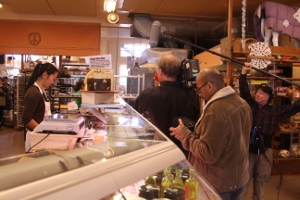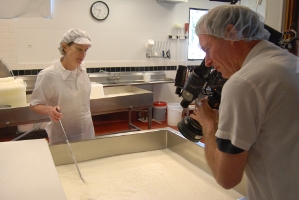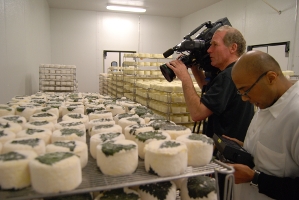To borrow a quote from the immortal Monty Python film, Life of Brian,“blessed are the cheesemakers.” Joking aside, cheesemaking is a veritable craft that has been around for thousands of years, with historical accounts attesting to the richness and popularity of cheese among different cultures and epochs. Roman author and philosopher Pliny the Elder wrote about the unique flavor of blue cheese more than 1,900 years ago, and Parmigiano-Reggiano cheese, or rather a grated mountain of it, was fancifully imagined by Bocaccio in his medieval collection of novellas, the Decameron.

Today, it’s hard to pin down exactly how many different cheeses exist in the world. As Professor Bart Weimer of UC Davis said in my "QUEST" science of cheese story, “cheese is evolving.” New cheeses are being created through the masterful brushstrokes of artisan cheesemakers who mix and match colonies of mold, yeast and bacteria to coax new shapes, textures and aromas into the canvas of the cheese curd. A “British Cheese Lovers Society” Facebook page, set up in association with the British Cheese Board, claims that there are over 700 varieties of cheese – in Britain alone.
The poet T.S. Eliot once quipped, “Never commit yourself to a cheese without having first examined it.” But that’s a tough task to accomplish, given the thousands of cheese available for savory consumption. So is there an intimidation factor when entering a crème-de-la-crème cheese shop like the Cheese Board Collective in Berkeley, where a blackboard lists the du jour cheese selections, from an Abondance semi-hard raw milk French cheese to Yarg, a semi-hard English cheese? (The goat and sheep’s milk cheese listings are equally prodigious).

San Francisco cheese author and educator Laura Werlin certainly thinks so, “because we didn’t grow up with cheese on the table or a variety of cheeses”, she said. “There’s very little cheese education, if you will, in this country,” she added, “and that makes it tough to know where to start.”

So to navigate this crumbly, creamy and fragrant labyrinth of cheeses, Werlin came up with a classification system to break down all the varieties of cheese into easily digestible styles: fresh, semi-soft, soft-ripened, surface-ripened, semi-hard, aged, washed rind, and last but certainly not aromatically least, blue cheeses.
